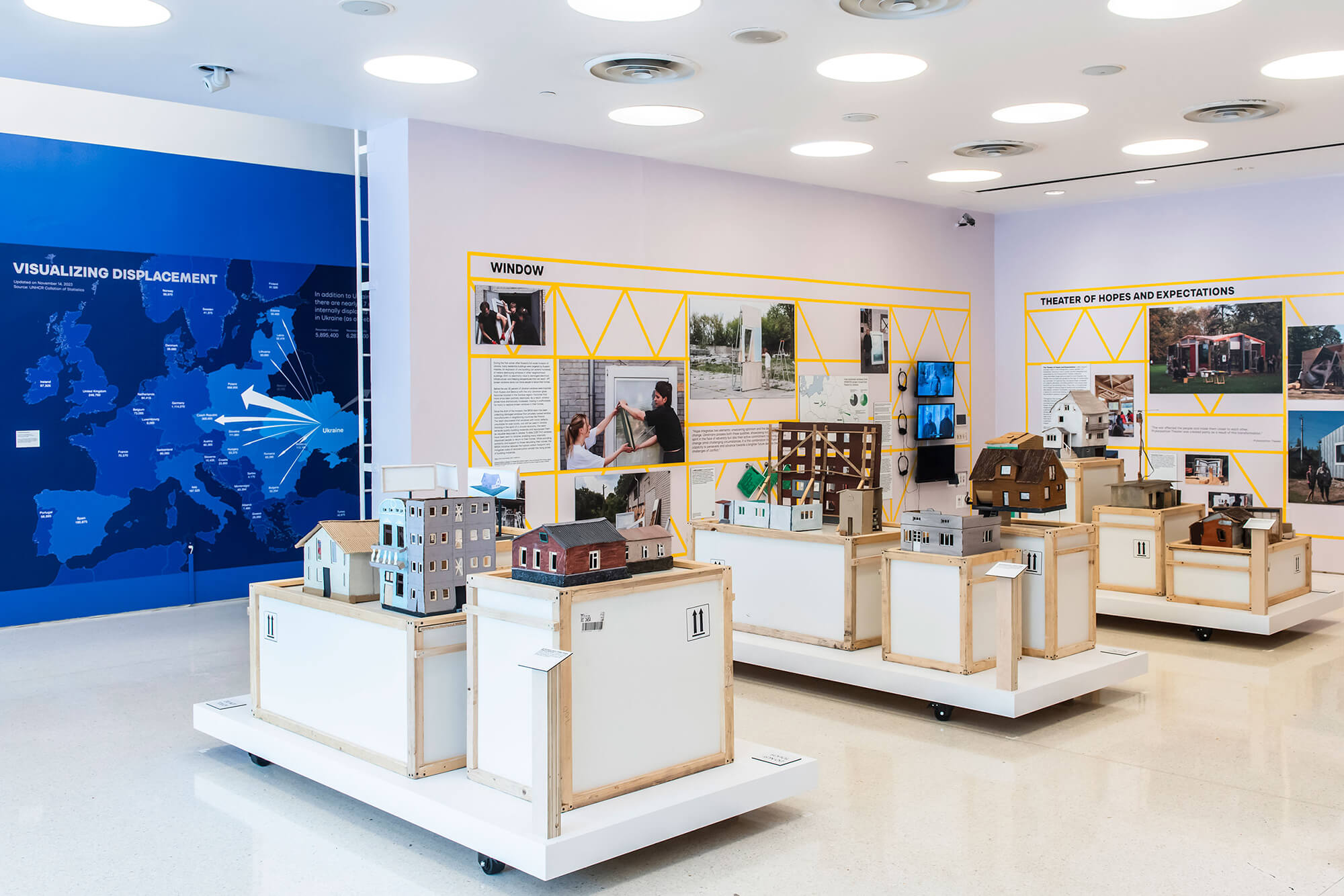Constructing Hope: Ukraine
Curated by Ashley Bigham, Betty Roytburd, and Sasha Topolnytska
Graphic design by Aliona Solomadina
Center for Architecture
536 LaGuardia Place
New York
Through September 3
If you’ve walked past New York’s Center for Architecture this summer, you’ll have noticed the translucent yellow diagonal strikes that accompany the signage for the Constructing Hope: Ukraine exhibition. Stepping into the first floor gallery, you’re greeted by a collection of eclectically painted cardboard models of apartments, garages, and bits of residential buildings elevated to around eye-level on three rows of pedestals in the center of the gallery. These artworks are flanked by images of a theatre under construction, sourcing logistics for windows, children’s furniture, and temporary shelters wrapping the walls. Tucked around the corner are infographics depicting Ukrainian refugee movements, following the Russian invasion of Ukraine in February 2022. The models are reconstructions of destroyed homes made by their one-time inhabitants.
The artists of the models are internally displaced people (IDPs) and refugees who participated in workshops led by the Prykarpattian Theater. Each session invited refugees from Ukraine, Syria, and Georgia to reflect on the apartments, houses, cottages, garages, backyards, and other buildings that constituted “home” for them by reconstructing them. These differ from the exactness of other exhibition pieces. Their roughness, shifting scales, and levels of resolution say something about the memories that these homes held: Why might more care be taken to recreate this specific, workaday window? These moments of special focus elicit questions at the heart of the Constructing Hope: Ukraine exhibition. What makes a house a home?
Constructing Hope: Ukraine, curated by Ashley Bigham, Betty Roytburd, and Sasha Topolnytska, showcases ways that everyday people maintain a sense of place and community in the face of dispossession. The exhibition has a broad range of participants from which a swathe of strategies appear: The NGO Metalab renovates buildings into emergency housing and designed a modular bed for IDPs; students at the Kharkiv School of Architecture designed spatial interventions for children; Repair Together entices volunteers for reconstruction with DJ sets while they work, to name just a few.
Even within this breadth of interventions, commonalities emerge between participants’ projects around memory, ground-up communal organizing, resiliency, and, most universally, what it means to construct a dignified home amid a crisis. As Tania Pashynska said, “So much creativity is possible when things become a must, when you have to figure things out.”
Immediately upon descending to the lower floor of Center for Architecture, exhibition goers are greeted by images of handwritten notes, and books with short stories on a small pedestal. Understructures is a publication of stories from Ukrainians reflecting on the first two months of the Russian invasion and what objects or artifacts gave them solace or made them feel at home. On the wall opposite Understructures are images and videos depicting people repairing destroyed structures while electronic music bumps in the background. The music mixes with the faint sound of conversation in Ukrainian, which wafts in from an adjoining room, where The Human Chain documentary is running on a loop.

Past the wall hosting Understructures, you find yourself in a taller room facing a small twin bed covered by a quilt, with a disassembled version of the same bed floating above in a sort of inspired by IKEA axonometric, surrounded by images of roof reconstruction, interior rehabilitation, and taped up windows reminiscent of the large yellow vinyl graphic that adorns the Center for Architecture storefront. The floating bed depicts the construction process of the beams fitting into the posts, and the mattress support unrolling over top. This is the Co-Haty bed, an easy to build, easy to deconstruct furnishing designed by the Ukraine-based NGO, Metalab.
Since the Russian invasion began, nearly one-third of Ukrainians have been forced to flee their homes. The influx of IDPs into Western Ukraine has led to an acute housing shortage. This bed and many other furniture types in the Co-Haty collection provide dignified temporary and long-term housing for IDPs in Ukraine. Metalab offers some insight into what makes a house a home through the Ukrainian words haty which means house, and cohaty which means to love. “Architecture is a place to be loved—home is a place where you feel loved. You see a physical difference when people settle into their space, when they feel at home,” said Tania Pashynska.

Anna and Tania Pashynska of Metalab spoke with Iman Fayaad, an assistant professor of architecture at the Harvard GSD, who wrote about the nature of identity and place in her recent New York Times op-ed, “A House is Not a Home,” as part of the exhibition’s dialogue series, which invited participants and outside academics. Ranging from the specifics of deconstruction in Ukraine to the crisis of housing shortages and the destruction of homes more globally today, the conversation ultimately centered on the importance of rebuilding.
The installations within Constructing Hope form a constellation of different strategies for rebuilding Ukrainian homes and bolstering Ukrainian citizens, but in each of them, there’s at least some kernel that questions what it means to seek home amid precarity. The saying goes, “If you want to go fast, go alone, but if you want to go far, go together.” Perhaps Constructing Hope: Ukraine is showing us a new way, where disparate strategies can all serve a common good and where we can go fast and far if we care deeply about a place, a home, care deeply about those around us, haty and cohaty.
Charles Weak is an architect and designer working in New York.

